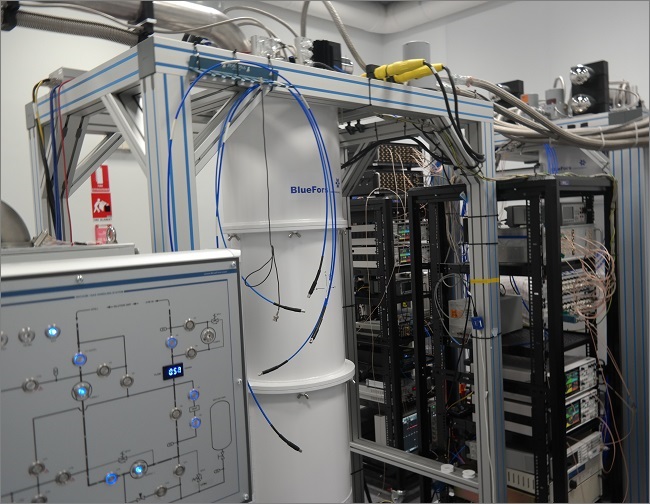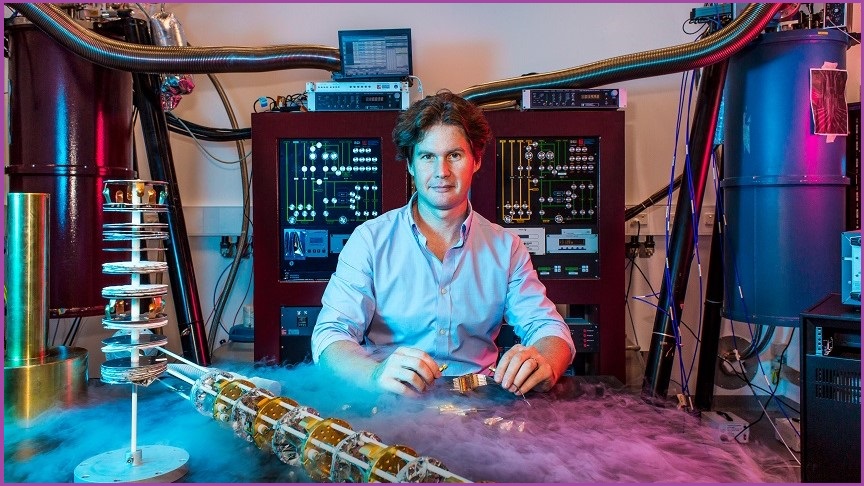Inside the University of Sydney’s Camperdown campus are some of the coldest places in the universe.
Hanging cocoon-like from a set of supports is a row of dilution fridges – cryogenic devices that are cooled down to temperatures approaching absolute zero.
Behind one fridge is a large grey container with a small sticker on it that says, ‘Made in the USA’.
As their nuclear warheads decay, the US military captures the helium-3 and supplies it to physicists like Professor David Reilly who, with his team comprising some of the sharpest minds in world, uses it to cool down the dilution fridges that help chip away at what could be the greatest science and technology problem for generations: quantum computing.
Professor Reilly made headlines in February with a breakthrough CMOS chip engineered to precisely control large numbers of sensitive qubits in the cryogenic temperatures needed to keep them stable.
He holds an unusual position as both an employee of Microsoft and the University of Sydney, balancing the academic and corporate worlds in search of a way to make quantum computers a reality.
“We were in this building from 2009 to 2015 trying to control single electrons,” Professor Reilly says as he points to the university’s 95-year-old Physics Building.
“The whole building moves. The temperature goes up and down, there’s wooden floors. It’s just impossible.”
Now Professor Reilly works in the purpose built, state-of-the-art, $150 million nanoscience hub – a crucial piece of 21st infrastructure nestled in between the heritage listed buildings of Australia’s oldest university.
Here, in rooms filled with computer equipment, large dilution fridges, and maths equations scrawled on window panes, Professor Reilly and his team works on completing what started as a pet project of Microsoft’s senior leadership – a project born from considering implications of computers that could better interact with the foundations of reality, and maybe even simulate the universe.
“But this isn’t like the Xbox,” Professor Reilly says. “We’re not going to have it ready by Christmas.”
The long game
Microsoft has poured large sums of money into the nanoscience hub quietly sitting among heritage buildings in Sydney’s inner-west.
The US tech giant’s reach extends beyond fabrication clean rooms and front desks, deep into the heart of the facility where increasingly large and sophisticated dilution fridges hold the pieces of Microsoft’s quantum future.
There is a steadying amount of hype surrounding quantum computers as tech giants and startups alike begin to sell the story that the next generation of computing is right around the corner and it will change the world.
It’s hard to simulate quantum phenomena.
Physical systems are complex enough to simulate without having to encode uncertainty and probability deep into its foundations.
Quantum computers will, in theory, allow for better simulations through direct access of the quantum phenomena classical computers struggle to emulate.

A high quality dilution fridge used for Microsoft's research. Photo: Casey Tonkin
There are potential ramifications for fields like pharmacology, logistics, finance, cryptography, communications, and artificial intelligence.
But we’re not quite there yet, and all the potential ramifications are just that: potential.
“Humans aren’t the best at predicting the future and it’s really hard to imagine what new applications will come from this,” Professor Reilly says.
“More importantly, the underpinning laws of physics are vastly different, and I find it personally very hard to believe that you can change the fundamental underpinning physics and not get anything new out of it.
“Whether it be thermodynamics and the industrial revolution, or electromagnetism and radio, television, Wi-Fi, history has shown that we move from the mathematics through the applied physics into the technology.
“And in each case, when you change the underlying physics you open up new areas of technology.”
The underlying physics are so confusing and counterintuitive that even Albert Einstein took issue with aspects of quantum physics and what it means for our understanding of the world around us, famously saying that God “does not play dice”.
And there remain large theoretical gaps between the micro world of quantum physics with its strange wave-particle dualities, superpositions, and entanglements; and the macro world of classical physics where large objects’ gravity literally warps space and time.
Erwin Schrödinger famously outlined the difficulty of reckoning some of the “spooky” aspects of quantum physics with the macro world in his thought experiment about a cat in a box that is simultaneously alive and dead.
“If you can build a quantum computer of scale, you will have actually realised a Schrödinger’s cat,” Professor Reilly says.
“It would be a macroscopic, large-scale object that is running entanglement, and superposition, and quantum measurement – phenomena that were once the domain of a billionth of a metre.”
But we’re not there yet.
24th century technology
Despite commanding a team of PhDs, and Silicon Valley investment that’s building bleeding edge technology, Professor Reilly’s outlook is modest.
He isn’t promising any radical, world-changing technology. He isn’t saying Microsoft will have realised a quantum computer with so-many qubits in 10 years – or even fifty years.
In fact, he isn’t sure a fully scaled quantum computer is even possible in our lifetimes.
“Quantum computing could be a technology of the 24th century,” Professor Reilly says.
“Or the 25th century; who knows? Maybe it’s too hard for now.”
It seems the state of quantum computing, as a set of concepts and theories materialised in large physical system, is currently in something like a superposition of its own; defying the binary ideas of ‘does exist’ and ‘does not exist’ to be simultaneously a technology you can play with in the cloud right now and something one of its foremost experts is unsure we will ever achieve.
“I was worried I’d retire and it’d be a bit like nuclear fusion where you’d be left saying ‘the basic ideas are right but it never really happened because we went down this path, not that path’,” Professor Reilly says standing outside the secured entrance to the University of Sydney’s quantum labs.
“I wanted to get to the point where I know it’s either going to happen or it’s not going to happen because we figured out it can’t due to some problem or limitation.
“I don’t want to die knowing.”










